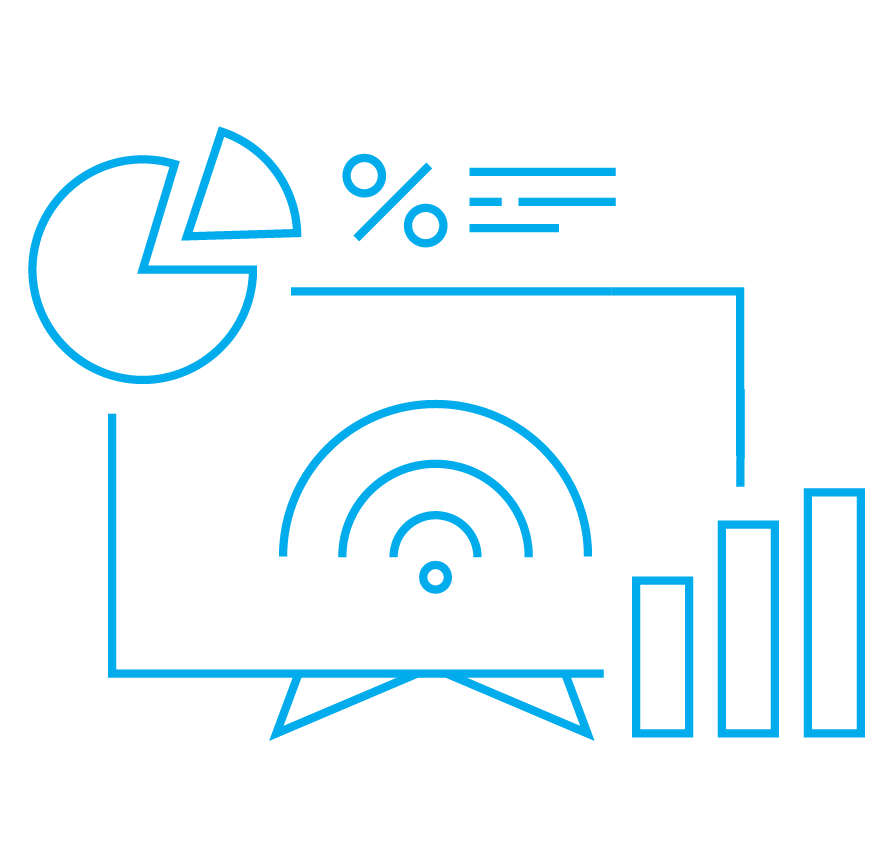- 1. CTV ad spend will surge
- 2. Marketers will turn to data & programmatic
- 3. Cookieless solutions will gain more popularity
- 4. Digital video ads will continue to rise
- 5. Marketers will take advantage of in-game ads
- 6. Mobile will stay the most used device
- The future is digital
CTV ad spend surge, cookie depreciation, AVOD, and data & measurement have been hot topics for the last year in the marketing world, and with a good reason. 2022 was a year of growing interest and intense development of these technologies and services. These advancements, according to the predictions, are bound to bear fruit in 2023.
Throughout our business activity and data analyses, we keep an eye on what’s trending in the digital marketing industry. We clashed our observations with digital marketing trend reports, insights, and forecasts to prepare a concise list of the most important trends and predictions for 2023. Have a look!
1. CTV ad spend will surge
Digital ad spend growth is expected to slow down but connected TV is one of the channels that will continue to thrive. CTV is a fast-growing technology that is not running out of momentum in 2023. CTV ad spending is expected to exceed $26 B this year, $5 B up from 2022.
TV audiences are often highly engaged, and connecting the devices to the internet allows ads to be more personalized which increases positive feedback and brings better results. Marketers are drawn to CTV because it already offers interactive ads, sending messages to the viewers’ phones, and shoppable ads that let them buy directly from the screen.
CTV keeps on advancing and improving. As of now, 87% of marketers invest in CTV ads. Most marketers spend no more than 25% of their budget on this channel, per Lotame’s Beyond the cookie report.
The challenges connected TV faces are:
- low accessibility of high-quality audience data,
- an unfriendly buying and planning process,
- lack of standardized ad effectiveness measurement.
In 2023 one of the issues for CTV (as well as other digital channels) will be creating metrics that effectively and transparently measure attention. There are companies like Lumen that use cameras in mobile devices to track eye movements to see what users are focusing on and for how long. While marketers demand precise attention metrics, the industry has to invent a widely available solution to plan and measure campaigns around the attention metrics.
2. Marketers will turn to data & programmatic
In uncertain economic times, marketers value flexibility and effectiveness above all else. That is why we expect programmatic budgets to fluctuate, but the ad spend will grow across display, connected TV, DOOH, and podcasting in 2023.
With the cookie depreciation looming, marketers are encouraged to explore new resources, technologies, and partnerships to reduce the impact of coming changes. What we see many companies do now is invest in developing Universal IDs or adopt technologies available on the market to identify users across multiple websites and devices.
Despite the challenges of a cookieless future, 80% of marketing leaders say data and analytics are key in discovering and upkeeping business opportunities, according to the CMO Council. Data enrichment, ID graphs, and third-party audience data are just some solutions businesses can use to improve their strategy and become more data-driven and, subsequently, more automated and effective.
In 2023 we’ll reach the point where the vast majority of data will be collected with full consent, we’ll notice a rise in contextual targeting outside the closed systems, and the winners will be those who embrace and master cross-media targeting, reaching the audience across all touchpoints.
3. Cookieless solutions will gain more popularity
Although Google pushed the third-party cookie depreciation to 2024, marketers are already bracing up and preparing for the cookieless future. EMarketer and LiveRamp report that 90% of AdTech and data companies are ready for the loss of third-party cookies.
Search for third-party cookie alternatives will continue throughout 2023, especially among other industries. According to Lotame’s survey, almost 90% of marketers and publishers plan to adopt new data and AdTech technologies soon.
Over 2022, brands became more active than ever in collecting and processing first-party data eligible for enrichment and monetization. According to Teads, half of the US publishers feel the deprecation of third-party cookies might be an opportunity to differentiate via their first-party data. Also, our team and the industry experts notice the growing interest in harnessing the data from diverse third-party sources they can use to create ID Graphs.
Among the most popular cookieless solutions the marketers test there are said ID graphs, universal IDs, Google Topics, and semantic and contextual targeting.
4. Digital video ads will continue to rise
Digital ad spend will hit $626,86 B in 2023, making up 69,2% of total media ad spend worldwide. With the dynamic CTV growth and video accounting for over half of the time users spend on social media, digital video ads are not going anywhere. Video is still one of the most engaging and attractive formats captivating wide audiences.
In 2023 we will see more video ads outside social media, too. With the emergence of new AVOD services, such as Netflix’s and Disney’s new, cheaper plans, the time spent watching ad-supported video might increase. According to eMarketer, AVOD will reach 44,6% US population in 2023. Dentsu predicts that time spent with AVOD channels will overtake time spent with subscription platforms due to Netflix’s and Disney’s new plans.
5. Marketers will take advantage of in-game ads
Gaming is, along with CTV, one of the under-monetized, fast-growing channels. According to eMarketer, many gamers are willing to spend on in-app purchases. In 2022 they spent $19,6 B. And while nearly half of them prefer free-to-play, ad-supported games, the in-game ad spending reached only $6,3 B in the US.
With 3.2 B estimated video game players globally, gaming is now a mainstream activity. Also, today we’re not only talking about PlayStation and PC games. The most popular games are the ones you can download to your smartphone and easily invite friends to join you. Non-gaming entities and social networks are new players in the field, as Netflix has a wide range of games, and TikTok and Snapchat are slowly introducing games in their apps.
Targeting the gamers while they play lets you reach an engaged audience at the peak of emotional involvement. With the correct gaming audience data, you can prepare a well-targeted, interactive ad that will draw gamers’ attention and drive results.
One of the awaited developments in the field of in-game advertising this year is the application of ACR (automatic content recognition) in gaming on CTV devices. With ACR data, the ads can be displayed based on almost real-time events, such as the player’s progress through the game, if they’re winning or losing at the moment, or what images they are seeing.
6. Mobile will stay the most used device
Mobile reaches 98% of internet users globally. On average, US users will spend more time on their mobile devices (over 4,5 hours) than on their computers in 2023. Also, mobile is preferred by millennials when shopping online. The mobile trend has been present for a while and keeps growing. At the same time, mobile ad spending is, surprisingly, not catching up.
Especially with the focus on cookieless solutions, mobile should have more recognition among marketers. Mobile in-app ads are often cookieless, and there are many ways of identifying and targeting a user on any device connected to the Internet. Universal IDs, ID Graphs, and MAIDs allow you to perform complex, cross-device campaigns incorporating mobile at any funnel level.
The growing mobile importance is closely linked with other trends, such as in-game advertising (73% of mobile users play mobile games), digital video (most video content is produced to be suitable for mobile screens), and focus on data. But because mobile is more intensely used than any other digital device, finding a way to engage consumers and improve the experience on their smartphones and tablets should be a priority.
The future is digital
The forecasts say that in 2026, digital ad spend will have accounted for 72,5% of total media ad spend worldwide, US CTV ad spend will have hit $43,59 B, and AVOD will have reached over half of the US population. In 2025 US mobile ad spend is predicted to hit $235,67 B. A complete switch to cookieless solutions also seems to come soon enough.
These are the signs that the trends emerging or growing in 2023 are not fads and investing in digital today means investing in the solutions of the future.



